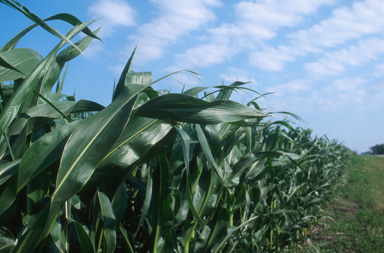
Agricultural News
Management Options for High Nitrate Forages Suffering Drought Damage
Tue, 12 Jul 2011 08:53:50 CDT
 The current drought situation is having multiple effects on many crops. The most obvious situation is the lack of forage growth. However, in many areas much of the corn that was planted as a grain crop has had some growth, but grain harvest is not economical. Thus, the most readily apparent alternative is to harvest this for use as an emergency forage crop.
The current drought situation is having multiple effects on many crops. The most obvious situation is the lack of forage growth. However, in many areas much of the corn that was planted as a grain crop has had some growth, but grain harvest is not economical. Thus, the most readily apparent alternative is to harvest this for use as an emergency forage crop.
There are many substantiated reports of forage nitrate concentrations ranging from 11,000 ppm up to 54,000 ppm in corn that could be harvested and used as a potential forage. Acceptable nitrate levels are less than 3,000 ppm. Nitrate levels up to 10,000 ppm can usually be managed by grinding the high nitrate and forage and blending it with non-nitrate containing forages.
It is critical that summer annual forages grown during drought be tested for nitrate. This is especially true for those crops, such as corn and sorghum that were planted primarily for grain since they often receive high levels of nitrogen to support grain production. At this time, it is almost certain that these crops will contain toxic levels of nitrate. For appropriate sampling and testing procedures, please see the June 29th newsletter article by Hailin Zhang entitled Hot and Dry Weather can Trigger Nitrate Accumulation in Some Forage Crops available at www.extensionnews.okstate.edu where articles are arranged by date.
The following options for managing drought-stressed, high-nitrate emergency forage crops such as drought-damaged corn should be followed to reduce or eliminate nitrate toxicity concerns.
Agronomically, the safest alternative is to allow these high nitrate crops to remain as ground cover for the next cropping season to serve as soil and moisture conservation. Likewise, much of the N will remain for subsequent cropping systems.
Under no circumstances should high nitrate forages be grazed. This practice is too risky under the current conditions. There is no easy way to manage toxic nitrate levels under grazing.
Whether the crop is harvested for silage or hay, it must be tested for nitrate. While there is some indication that ensiling will reduce nitrate concentration, the reduction will not be great enough to offset the toxicity concerns, especially for those forages above a nitrate concentration of 20,000 ppm. Curing as hay has no effect on reducing nitrate concentration.
If high nitrate forages are harvested for silage or hay, they must be mixed or blended with other forages that are low and preferably absent of nitrate.
The current lack of almost type of forage is resulting in difficult decision making for many producers. Although management options exist, be aware that some of the choices may result in further livestock losses.
If you have any questions on testing, harvesting, or feeding high nitrate forages, please contact your county extension educator for more information.
Our thanks to Daren Redfearn, Oklahoma State University Plant and Soil Sciences, for providing this article through the Extension News. More articles from the Plant and Soil Science Extension News can be found by clicking here.
WebReadyTM Powered by WireReady® NSI
Top Agricultural News
More Headlines...



















